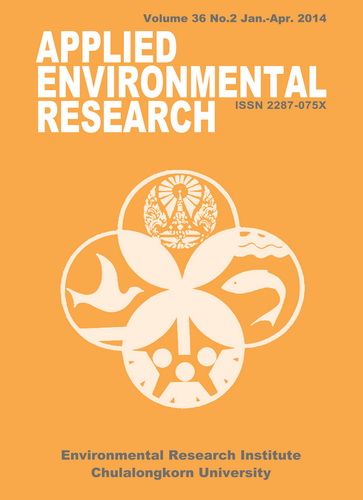Incremental Concentration of Black Carbon Aerosol from Road Traffic in Inner Bangkok
Main Article Content
Abstract
Commonly referred to as soot, black carbon (BC) is a primary aerosol emitted from incomplete combustion of organic materials such as fossil fuels, biofuels and biomass. BC aerosol is a dominant anthropogenic solar radiation absorber, absorbing approximately 1 million times more radiation per unit of mass than CO2. Recent research has found that BC is the second largest anthropogenic contributor to global warming. BC aerosol is not only a short-lived climate forcer (SLCF) but also an air pollutant that adversely affects human health. Emission sources of BC aerosol are mainly residential, industrial, transportation related and/or and open burning sources. In a large city with serious traffic congestion such as Bangkok, vehicles are the most significant source of BC aerosol. The objective of this study is to determine BC concentrations in Bangkok’s ambient air caused by road traffic. BC concentrations in the center of Bangkok city were measured using an aethalometer located on the rooftop of the Department of Environmental Engineering’s five-story-building at Chulalongkorn University, Bangkok. Measurements were carried out in the dry season of January 2013, when atmospheric aerosol concentrations are high. BC concentrations were measured on a 24-h basis for a continuous 7-d period. The results reveal diurnal variations that follow local traffic patterns. Except on Sundays, diurnal BC patterns were generally bimodal in both mornings and evenings. During weekdays, BC concentrations peaked in the morning at 4.01 µg m-3 and in the evening at 3.71 µg m-3, with an average value of 3.08 µg m-3. On Saturdays, BC concentrations peaked in the morning at 2.16 µg m-3 and in the evening at 2.24 µg m-3, with an average value of 1.76 µg m-3. On Sundays, BC concentrations showed only small variations throughout the day, ranging from about 0.93 to 1.41 µg m-3, with an average value of 1.16 µg m-3. It can be concluded that the baseline BC concentration in the inner Bangkok area is approximately 1 microgram per cubic meter. In the present case, contributions to ambient atmospheric BC concentrations from traffic were 3-4 times higher than the baseline concentration, indicating that green transportation is urgently needed to reduce SLCFs and air pollution in Bangkok city.
Article Details

This work is licensed under a Creative Commons Attribution-NonCommercial 4.0 International License.
Published articles are under the copyright of the Applied Environmental Research effective when the article is accepted for publication thus granting Applied Environmental Research all rights for the work so that both parties may be protected from the consequences of unauthorized use. Partially or totally publication of an article elsewhere is possible only after the consent from the editors.

